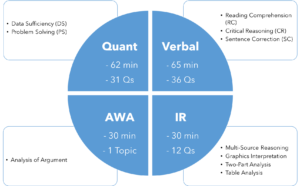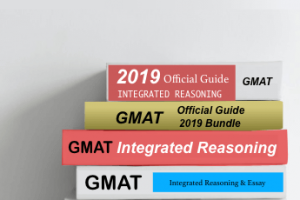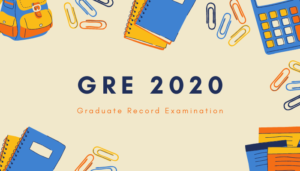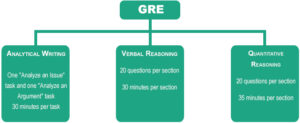by Labhesh | Nov 13, 2020 | Admissions counselling, GMAT, Motivation, study abroad, Test

GMAT Exam Format
The GMAT Exam tests you on the following four sections:
- Analytical Writing Analysis
- Integrated Reasoning
- Quantitative
- Verbal
Here’s a concise GMAT Exam Format of every one of these segments:
- AWA – “The Analytical Writing Assessment (AWA) measures your capacity to think fundamentally and to impart your thoughts. During the AWA, you are approached to break down the thinking behind a given argument and compose a study of that argument”.

Analytical Writing Analysis
- Duration: 30 minutes
- Analysis of Argument for 1 Topic
- IR – “The Integrated Reasoning area of the GMAT estimates your capacity to assess data introduced in different arrangements from numerous sources – abilities you have to prevail in our innovatively propelled, information driven world.”

Integrated Reasoning
- Duration: 30 minutes
- 12 Questions of the accompanying question types:
Multi-Source Reasoning
Graphics Interpretation
Two-Part Analysis
Table Analysis
- Quant – “The Quantitative segment quantifies your capacity to break down information and make inferences utilizing thinking abilities. The arithmetic expected to comprehend and solve the questions in this segment of the GMAT test is no more prominent than what is for the most part instructed in secondary school classes.”

Quantitative Reasoning
- Duration: 62 minutes
- 31 Questions of the accompanying question types:
Problem Solving (PS)
Data Sufficiency (DS)
- Verbal – “The Verbal segment gauges your capacity to read and comprehend written material, to assess contentions, and to address composed material to adjust to standard composed English.”

Verbal GMAT
- Duration: 65 minutes
- 36 Questions from the accompanying themes:
Reading Comprehension (RC)
Critical Reasoning (CR)
Sentence Correction (SC)
Do refer to our GMAT exam syllabus article!!
Also know the GMAT Score calculation before you step into the examination hall. Good luck champs!!
by Labhesh | Nov 11, 2020 | Admissions counselling, GMAT, Motivation, study abroad, Test

GMAT Exam Syllabus
Before reading the GMAT Exam Syllabus, know what is GMAT and the reason behind taking the GMAT Exam.
GMAT Analytical Writing Assessment Exam Syllabus

GMAT Analytical Writing Assessment Syllabus
The Analytical Writing segment will have subjects on which the applicant should write, or passage might be given on which questions will be posed. Based on the passage, the applicant should answer. The schedule for this segment is tremendous and differed as the subject of the section could be any subject of intrigue. The principle thought is to concentrate on the structure of the appropriate response and not the arguments introduced. Keep in mind, it’s anything but a trial of your sentiment yet your writing style, so it is more secure to adhere to unbiased assessment according to the GMAT Exam Syllabus.
In this area, you need to examine the thinking and afterward present your argument. Keep in mind, you will be decided on how all around contemplated you locate a given argument.
In this area, you need to write an essay on the issue given to you. The applicant needs to offer an input in around 600 words. The opinion can be supportive of the given articulation or applicants can offer their own input. Be that as it may, make a point to offer your input in an appropriately organized way as you will be decided on this premise.
GMAT Integrated Reasoning Syllabus

GMAT Integrated Reasoning Syllabus
The Integrated Reasoning area is the freshest expansion in the GMAT Exam Syllabus. This area tests the competitors’ capacity to assess the information introduced in chart or table organization. This segment has 12 questions of the following kind:
This area gauges applicants’ capacity to sort and analyse a table including information, similar to a spreadsheet, to decide the significant data or the one that meets certain conditions.
Measures the competitors’ abilities to take care of complex issues. The issues can be verbal, quantitative, or a blend of both. The configuration is flexible and covers a wide scope of substance. The candidate’s ability to tackle simultaneous equations, assess compromises, and observe connections between two substances is estimated.
It gauges competitors’ abilities to inspect information from various sources tables, illustrations, text sections, or a mix of all the three and analyse each source of information cautiously for addressing numerous questions. The candidates will be approached to draw deductions and others may expect you to decide if information is significant. In a couple of questions, applicants should perceive inconsistencies among various sources of information.
It quantifies candidate’s capacity to interpret the data introduced in a diagram or graphical picture (scatter plot, x/y chart, bar outline, pie graph, or statistical curve distribution) to discover connections, and make deductions.
GMAT Quantitative Reasoning

GMAT Quantitative Reasoning
The Quantitative Section includes two areas, in particular Data Sufficiency and Problem Solving. In the Data Sufficiency area, there will be 18 questions and, in the Problem-Solving segment, there will be 18 questions. The questions will be target type and will have various decision answers. In this area the questions can be normal from the accompanying math syllabus:
It gauges the applicants’ abilities to utilize rationale and systematic thinking for taking care of quantitative issues.
It quantifies the candidate’s capacity to inspect a quantitative issue, distinguish which information is significant, and decide when there is sufficient information to take care of the issue.
The themes are additionally partitioned into the accompanying classifications:
- Geometry
- Elementary Algebra
- Arithmetic
- Ratio Proportions
- Properties of Integers
- Permutation and combinations
- Exponents and roots
- Linear equations etc.
GMAT Verbal Reasoning Syllabus

GMAT Verbal Reasoning Syllabus
This Verbal Skills area will have 36 multiple choice questions. This area is partitioned into Critical Reasoning, Reading Comprehension and Sentence Correction. This segment tests the applicants’ capacity to appreciate the composed material, read and understand the consistent connection between the focuses referenced in the passage and concepts.
It gauges the applicants’ expertise to make arguments, to assess arguments, and detail or assess a strategy.
It gauges the candidate’s aptitude to draw deductions, comprehend legitimate connections between noteworthy points, get words and proclamations, and follow the improvement of quantitative ideas. Aside from this, the applicants’ will be tried on the accompanying understanding abilities: derivation, application, fundamental thought, supporting the thought, intelligent structure, and style.
This area estimates two wide parts of the competitors’ language capability. The main angle is to address articulation while alluding to sentences that are syntactically and fundamentally stable. The subsequent perspective is a successful articulation while alluding to sentences that adequately express a thought or relationship obviously, compactly, and linguistically.
Following areas will be covered in this Verbal Reasoning area:
- Critical thinking
- Rhetorical development of the sentences
- Sentence adjustment identified with discovering blunder or exclusion
- Reading unseen passages
- Subject-action word understanding
- Misplace modifiers
- Countable Vs Uncountable
- Parallelism
Register yourself with Anannt and ace the exam.
by Labhesh | Nov 7, 2020 | Admissions counselling, GRE, Motivation, study abroad, Test

GRE Tips
After what appears unlimited long periods of studying, pulling dusk ’til dawn affairs before tests, wrenching endlessly essays in the library and endless pots of espresso, you’ve at long last earned your certificate and have your eyes set on graduate school. The considering is a long way from being done, in any case, as your next success is the Graduate Record Examination.
Graduate programs across the nation over view the GRE as the foundation of your application.
So know the GRE Tips before you enter the Examination Hall.
Study Smarter, Not Harder

do it the smart way, not the hard way
You wouldn’t go to the rec center, subjectively pick which loads or machines to utilize, and hope to see the best outcomes. Utilizing a framework and concentrating on specific regions inside a set timetable would better assist you to accomplish your objectives. The equivalent is valid for studying for the GRE: on the off chance that you build up a deliberate way to deal with studying, including working more earnestly inside territories that need improvement, you’ll get results all the more rapidly and end up nearer to your objective score.
Distinguish how you study and, all the more significantly, how you learn. A few people learn better when they record things, while others have to hear the data for the information to soak in. Thinking back to effective investigation propensities from school can be useful in deciding your learning qualities and making a strong report plan.
Utilize the Right Study Tools

use the right tools
A study program must be good compared to the materials you use. Luckily, there are huge amounts of assets accessible that assist you with concentrating adaptively, so you can consider the material you have to audit while bypassing coursework you definitely know.
Try not to Plan on the Cram

students need to plan, not cram
Cram studying isn’t valuable for protecting “mental acquisition.” If you study a day or two preceding the test for eight hours every day, in addition to the fact that you are going to wear out, you’re bound to get a lower score. Nothing you study will stick. Similarly, as significant is taking a vacation day before the test. Permit yourself to unwind before the mental acrobatics your brain will do during the GRE.
Try not to Worry, Be Happy

be calm and happy
Finding the right mental composure is tied in with seeing the test positively and realizing you put the time in to comprehend the test completely. Visit the test place the day preceding so you know precisely how to arrive and what traffic might resemble. Have a companion drop you off to keep your psyche clear and straightforward. Take full breaths. You may even consider doing some light exercise in advance. Also not able to decide the GRE Exam Date? Be calm and refer to the link attached.
Find the test centers and dates for GRE.
by Labhesh | Nov 5, 2020 | Admissions counselling, GRE, Motivation, study abroad

The GRE Exam Date
There are a ton of GRE test dates each year, which is extraordinary for giving you choices, yet it can make picking the best GRE Exam Date a challenge. When would it be a good idea for you to take the GRE? Continue reading to gain proficiency with the answer to this question.
- The General Test is offered all year at Prometric® test centres, and furthermore on specific dates at extra testing areas outside of the Prometric test centre network. Arrangements are planned on a first-come, first-served basis.
- When choosing a test date, ensure your scores will be accounted for in an ideal opportunity for your application deadlines. Score reports are sent to your assigned score beneficiaries roughly 10–15 days after your test date.
- You can take the GRE General Test once every 21 days, up to five times inside any nonstop moving year term (365 days). This applies regardless of whether you dropped your scores on a test taken beforehand.
Know The GRE Score Board before you choose The GRE Exam Date.
Instructions to Figure Out The GRE Exam Date

Decide the GRE Date
The most significant data you have to decide your GRE plan is when scores must be gotten for every one of the schools you’re applying to. These deadlines are regularly in the pre-winter or late-fall, however make certain to discover the specific GRE Exam Date for every one of your schools. Likewise, the deadline your GRE scores should be gotten by could possibly be the date your application should be submitted. Ensure you locate the right date.
Locate the soonest deadline among every one of your schools, and star it, circle it, write it in monster letters on a bit of paper, whatever you need to do to focus on it. This is the date when your scores totally should be gotten. In case you don’t know which schools, you need to apply to, use November fifteenth as your deadline. This is an early enough date that you’ll be inside the deadline for by far most of schools.
Obviously, the most famous time matches with the application deadlines for most alumni programs – pre-fall and fall. In the event that you might want to take your GRE test during this time, at that point you should enrol for GRE at the earliest opportunity. The closer the GRE test date is to the application cut-off time, the snappier the openings will get topped off. Recall that test places for GMAT and medical boards are regularly same as GRE test centres, and you would be competing with every one of them for a seat.
Another highlight consider is that the afternoon spaces top off first. In the event that you are not a morning individual and might want to step through the examination toward the afternoon, you have to book the GRE test date somewhat sooner than something else. Recall it is about your convenience – the test itself wouldn’t be radically extraordinary on the off chance that you take it toward the beginning of the day as opposed to the evening.
When you have that date, work in reverse to make sense of when to take the GRE.
The Quick Method for When to Take GRE

quick method to decide The GRE Date
The quick and simple strategy for making sense of which GRE Exam Date to choose is to give yourself 2-3 months of planning time before you take the GRE. This will give a great many people sufficient opportunity to get ready for the test.
On the off chance that you need to leave space for retakes, include one month for each retake (two retakes are generally enough). You have to hold up in any event 21 days between each GRE you take, and leaving a month between tests gives you sufficient opportunity to make sense of the slip-ups you made and how to stay away from them.
Additionally, ensure you take the GRE at least three weeks before school deadline times so you’ll be certain schools get your scores in time.
So, in a nutshell, take your first GRE 3-4 months before your school deadlines, and begin considering 2-3 months before that. That is your straightforward response to when to take the GRE.
Also, know few things before you appear for The GRE.
by Labhesh | Nov 4, 2020 | GRE, Motivation, study abroad
Having an advanced degree on your resume can widen your opportunities. In line with it, the recent data from the Bureau of Labour Statistics and The Organisation for Economic Co-operation and Development depicts education’s role in increased earnings and low unemployment rates. Regardless of where you are going, be it a graduate school consisting of business or law, or simply just exploring different options, you are working towards making a necessary and unavoidable step for your future. Do we know what is GRE and its scoring system (The GRE score board)?
Well, let’s find out!
Register yourself for a free GRE demo class!
So, What is GRE?

What is GRE?
GRE, short form of Graduate Record Examination is owned and monitored by Education Testing services whose headquarters is recited in Princeton, New Jersey. Choosing GRE general test or the GRE subject test all depends on the course that the person is going to undertake or what the specific admission team requires from the student. However, the focus is on the GRE general test, considering the importance and popularity amongst the universities and the test candidates.
The GRE General Test is a computer based test that showcases the kind of thinking the candidate does through questions, the skills required to succeed in today’s day and age. The test taker permits you to skip questions within a section, go back and forth to change answers and nevertheless have the flexibility to jump between questions by choosing what to answer first. It helps you measure your verbal reasoning, quantitative reasoning, and analytical writing skills. These are the skills that have been built over a long period of time unrelated to any specific field of study but however necessary for all.
Do they follow a specific format?

follow a specific format
Total time of 3 hours 45 minutes, the test includes of 2 verbal sections, 2 quant sections and 1 Analytical writing section. Moreover, an additional Verbal or a Quant part which is either not a scoring experimental section or non-marked research question.
Order wise, Analytical writing comes first, followed by either verbal or quant in an unknown and random order. So thus, you can either have 1 verbal and then 1 quant or 2 verbal sections at the same time followed by 2 quant questions.
Finally, The GRE score board!!

The GRE score board
With a clear picture of what GRE is and its format, lets lastly dig into and understand The GRE score board.
The candidates are scored on three aspects:
- A Verbal Reasoning score is marked on a 130–170 score scale, in 1-point increments.
- A Quantitative Reasoning score is marked on a 130–170 score scale, in 1-point increments.
- An Analytical Writing score is marked on a 0–6 score level, in half-point increments.
Verbal and Quantitative Reasoning section:
The Verbal Reasoning and Quantitative Reasoning sections of the GRE general test are section-level adaptive. This depicts that the computer chooses the second section of a measure performance based on the first section. Amongst all the sections, all questions hold equal weight towards the final score. Before the final score, a raw score is compiled for both the measures. Note: The raw score is the correct answer given for each question.
The raw score is transformed to a scaled score through a procedure well known as equating. The equating procedure accounts for small changes in difficulty between the various test editions along with differences in difficulty between individuals’ tests initiated by the section-level adaptation. Hence, a given scaled score of a specific measure mirrors a similar degree of execution paying little mind to which segment was chosen and when the test was taken.
Analytical Reasoning section:
Every essay gets marked by at least one trained rater, keeping in mind a six-point holistic scale. In comprehensive scoring, raters are prepared to give scores based on the general and the overall nature of the essay. The paper score is then scored by e-rater®, an automated program created by ETS that is fit for distinguishing article highlights identified with composing capability. If for say the scores of both the humans and the e-rater match or are close enough, the average of both the scores in considered as the final score. But however, if thy deviate a subsequent human score is gotten, and the final score is the average of the two human scores.
The final scores on the two articles are then arrived at the midpoint of and adjusted to the closest half-point stretch on the 0–6 score scale. The individual score is accounted for the Analytical Writing measure. The primary focus in scoring the Analytical Writing section is on your basic reasoning and analytical writing skills instead of grammar and mechanics.
Finally, after comprehending The GRE score board, has the article helped you in gaining a deeper insight about the scoring system pattern? If you have any doubts or suggestions, leave a comment in the comment section down below!
Know the most common GRE Vocabulary words, ranging from least difficult to most difficult.
by Labhesh | Oct 29, 2020 | ACT, Motivation, study abroad, Test

follow the Recommended Step-By-Step Approach To The ACT Essay
The whole challenge of the ACT essay is to write an essay in 30 minutes that includes the features that tend to appear in top-scoring ACT Essays. As I’ve said repeatedly, there are a few different ways to do this, but I find the following Recommended Step-By-Step Approach To The ACT Essay the easiest and most straightforward. After we go over this process, I’ll write a sample essay using these guidelines in the next section. Finally, we’ll finish our discussion of the ACT Essay by analysing the example essays from the Red Book, to see how they demonstrate the concepts we’ve discussed.
Before reading about the steps to the ACT Essay, get familiar to the Unwritten Test Design Rules of The ACT Essay
1. Watch The Clock, one of the Recommended Step-By-Step Approach To The ACT Essay.

stay focused
You only have 30 minutes, so losing focus for just a few minutes could really harm your score. Do your best to stay focused and keep writing until you’ve made it onto the third page of writing room and finished your essay—for most people, that will take up practically all of your 30 minutes.
2. Read The Prompt And Pick A Side.

choose a side
The prompt will address some issue related to the everyday lives of high-school students, so it shouldn’t be too hard for you to decide how you feel about it—or at least to pick a side that you can support.
Of course, there’s no right or wrong answer to the prompt, and the grader isn’t allowed to penalize you or reward you based on whether she agrees with your position. So just choose the side that seems easiest to support.
Moving to the 3rd Recommended Step-By-Step Approach To The ACT Essay
3. Come Up With 3 Reasons And/Or Examples To Support Your Side in the ACT Essay.

support your side with an example
You’ll need these reasons or examples to fill out your essay and support your thesis. Remember that one of the most important things about your essay is that your reasons or examples must clearly support your position. Also remember that the reasons and examples don’t have to be true or academic—they can be true or academic, or both, if you want, but the graders aren’t allowed to care either way. The only thing that matters is that your reasoning and examples would support your thesis if they were true.
4. Write Your Introduction, Including Your Thesis Statement.

start with an introduction
Now that you’ve picked a side and thought of some ways to support it, start writing.
Remember that this is a 30-minute essay test, and length counts more towards your score than any other single thing. You don’t want to waste time.
Your introductory paragraph should include your thesis statement. In addition to your thesis statement, you just want a few sentences related to the topic to fill out your essay.
You can fill out the rest of your opening paragraph by referring to the examples you’ll be using, like the 5-scoring essay does on page 133 of your copy of the Red Book. Or you can just write filler material on the general topic of the prompt, like the 6-scoring essay on page 137 of the same book does in its opening paragraph. The most important goal to accomplish with the introductory paragraph is to state your thesis clearly.
5. Write Your Supporting Paragraphs, Using Examples And/Or Reasoning.
Once you’ve finished your introduction, you’re ready to write your supporting paragraphs. This is the bulk of your essay, and length counts. I recommend one paragraph per example or reason, so if you have three examples to write about, you’ll end up writing three paragraphs.
Three isn’t necessarily the magic number of supporting paragraphs. You could do just two if you expanded on them enough to fill out more than two pages in total, or you could do four or five if you could think of that many ways to support your position, and if you could write about all of them quickly enough to finish on time. In general, though, I find that three supporting examples or reasons is the best number for most people.

follow the structure below
Each support paragraph should more or less follow this structure:
· General statement that introduces what that paragraph will be about
· 3-5 sentences describing your reason or example
· 1-2 sentences relating this reason or example to the thesis.
Once you’ve written a paragraph like this for each example, I recommend you address counterarguments.
6. Address Counterarguments, as mentioned in the Recommended Step-By-Step Approach To The ACT Essay.

address counterarguments
You’ve got most of your essay written by now, and you should be around halfway down the second page, or possibly even further along than that. Now you need to address counterarguments.
Your counterarguments paragraph should indicate that you’re aware of reasons why someone might disagree with your answer to the prompt, but that people who disagree with you simply aren’t aware of something that makes your position best. For examples of this type of paragraph, see my sample ACT Essay on the next page, as well as the sixth paragraph of the “perfect” 6-scoring ACT Essay that starts on page 137 of the Red Book.
7. Conclude The Essay.

conclusion starters
At this point, you should be near the bottom of page 2, or even starting on page 3. It’s time to write your conclusion and finish your essay.
Start with a couple of sentences reasserting the position you took in the beginning of the essay. Then, in another couple of sentences, re-summarize your reasons and examples, and wrap up your thoughts. If necessary, you can draw this summary out to get to the third page (remember that the length of your essay is the single most reliable indicator of its score).
Now that we’ve discussed this Recommended Step-By-Step Approach To The ACT Essay in abstract, let’s take a look at some examples! On the next page, you’ll see me construct a sample ACT Essay using this process. After that, we’ll analyze the exemplar essays in the Red Book to see how the top-scoring ones follow the principles we’ve been talking about.
Know the ACT Essay Writing Tips!
Example ACT Essay






























Recent Comments